[ad_1]

One thing very mysterious is happening with a sadly obscure however fondly remembered gem from the Famicom period. It was constructed on the identical sport engine as the unique Legend of Zelda, however in contrast to Hyperlink who many years on stays on the vaunted heights of gaming’s all-time greats, the protagonist of this bygone traditional by no means even obtained a correct worldwide launch in its day, by no means thoughts a sequel.
Spare a thought, then, for the lone samurai Takamaru.
To say that The Mysterious Murasame Fortress, initially launched in 1986 on the Famicom Disk System, nonetheless holds up effectively is an understatement. It gives up among the snappiest gameplay of the 8-bit period and has over time been given quite a few nods by Nintendo themselves. The truth that it stays lacking in motion on the Swap is each baffling and a obvious missed alternative.
That’s notably for the reason that latest closure of the 3DS eShop eradicated the one technique of legally buying the sport with its first worldwide launch in 2014 by way of Digital Console. Aside from the proprietary floppy disks that ran on the Famicom’s Japan-exclusive {hardware} add-on, its solely different bodily launch got here when was ported to the Sport Boy Advance in Japan in 2004.
At the moment, Murasame Fortress is at present nowhere to be seen on the Nintendo Swap On-line service, neither within the West nor Japan, making the 36-year-old title extra elusive than ever. That may be a actual disgrace, particularly contemplating how revered it continues to be, with the likes of Hideki Kamiya and Suda51 each saying lately how they’d like to do a contemporary reboot.
However what precisely makes this sport so compelling? Murasame Fortress is the end-product of the Zelda crew’s experimentation with including velocity to their sport engine. Although retaining a top-down angle, it eschews the puzzling and slower-paced exploration of Hyperlink’s maiden entry in favour of a extra linear, action-oriented expertise that, oddly sufficient, is usually in comparison with a bullet-hell shooter.
Set in Edo interval Japan, the expert swordsman Takamaru is known as upon by the ruling shogunate after an extraterrestrial object falls out of the sky and possesses the big stone statue of a creature often called Murasame, which makes use of its darkish affect to take management of the titular fort whereas possessing the daimyos, or lords, of 4 different neighbouring castles.
Wielding a katana for shut quarters and an infinite provide of upgradable shuriken for ranged assaults, Takamaru should beat again wave after wave of ninjas, demons, and various baddies whereas infiltrating every of the 5 castles. With seemingly all the pieces that strikes making an attempt to kill you, a medley of fantastically catchy themes from legendary composer Koji Kondo ties it collectively superbly.
Like many video games of the period, Murasame Fortress is tough – particularly so in its latter half. Although it is usually truthful and surmountable, with a checkpoint system initially or mid-point of every respective stage. It’s fully a sport of talent, with progress relying on the participant’s prowess in weaving via chaotic battles and grabbing power-ups for more practical killing blows.
Takamaru can parry most incoming projectiles whereas shelling out fireballs, casting lightning bolts, and harnessing invisibility. Every fort brings progressively harder foes and frantic battles, with the one reprieve being further lives granted when daughters of noblemen held captive within the castles are rescued. The blue-haired warrior can stand up to three hits from an enemy earlier than shedding a life.
In distinction to the fantastical Mushroom Kingdom and Hyrule, Takamaru’s world is one steeped in Japanese tradition, and it’s mentioned that this obvious lack of ‘common enchantment’ was the issue that the majority performed into its Japanese exclusivity. However the Nintendo Leisure System was no stranger to ninja video games and Japanese themes, and Murasame Fortress’s gameplay completely speaks for itself.
[ad_2]
Source link


